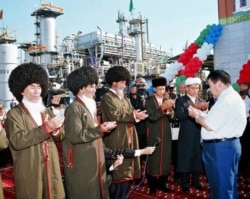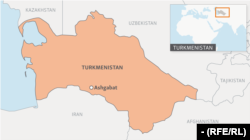
When the crucial OPEC+ meeting broke up on March 8 after major disagreement between Saudi Arabia and Russia, it sent the price of oil plunging.
Other countries dependent on oil exports for revenue could only watch with trepidation during the succeeding days as oil prices continued to sink.
Prices did finally stabilize in late March, though at levels significantly lower than they were just weeks earlier.
But the lockdowns around the world caused by the spread of the coronavirus and the accompanying reduction in economic activity resulted in a drastic reduction in the need for oil, leaving a massive glut in supplies.
There was plenty of oil but fewer customers, and storage space for the extra oil quickly reached capacity, leading to a second crash in oil prices on April 20 with West Texas Intermediate (WTI) falling briefly below $0 per barrel.
WTI's nadir dragged the price of other oils like Brent Crude and Urals down with it and some people in the oil business are saying the glut, and historically low prices, could remain for months.
On the eastern side of the Caspian Sea, the governments in Kazakhstan and Turkmenistan must surely be wringing their hands in despair -- in Ashgabat more than in Nur-Sultan.
Comparisons are being made to oil prices in 1998, when the average cost of a barrel of oil was less than $20.
What do 1998 prices mean for Kazakhstan and Turkmenistan?
Latest Economic Disaster
Starting with Turkmenistan, this is just the latest in a series of economic disasters the country has been facing for nearly five years.
Turkmenistan's major export is natural gas and, by most estimates, since the Turkmen government is reluctant to release economic figures, gas exports account for somewhere between 70 and 80 percent of the country's revenue.
And, unfortunately for Ashgabat, the price of gas follows the price of oil.
In 1998, Turkmenistan was locked in tense negotiations with Russia over the price of Turkmen gas.
In those days, all Turkmen gas was still exported (to Ukraine, Georgia, and Armenia) through Russian pipelines, a legacy of the old Soviet infrastructure.
A new gas pipeline to Iran had opened at the end of 1997, but the initial volume being shipped was low, making Russian pipelines really the only option for Turkmen gas exports.
Turkmen President Saparmurat Niyazov wanted $40 per 1,000 cubic meters and Russia was standing by an offer of $32.
Fast forwarding almost 20 years, a dispute over gas prices led to Russia suspending gas imports from Turkmenistan altogether at the start of 2016.
Gazprom finally reached a deal with Turkmenistan in 2019 to purchase a modest 5.5 billion cubic meters (bcm) of Turkmen gas at a price that one report said was "a very low price -- no more than $110 per 1,000 cubic meters."
China is purchasing more Turkmen gas than Russia, some 35 bcm in 2019.
China was reportedly paying Turkmenistan $185 per 1,000 bcm as of 2016. However, there were reports in 2017 that China was seeking -- and as Turkmenistan's sole gas customer at the time probably obtained -- an agreement for a lower price.
No Leverage
Turkmenistan has no real leverage in talks on gas prices with either Russia or China and it is almost certain both will soon be contacting Ashgabat with new proposals for a lower price for Turkmen gas.
Those are Turkmenistan's only two gas customers.
Russia actually does not even need Turkmen gas and China said in early March that it would be reducing gas imports via pipelines and focusing on liquefied natural gas (LNG) imports.
If $110 per 1,000 bcm was considered "a very low price," then $32-$40/1,000 bcm is practically pocket change. But that is probably close to what the price of Turkmen gas will be for much of this year.
As mentioned many times previously, an unknown portion of Turkmen gas exports to China go toward paying off Turkmenistan's debt to Beijing for loans to develop the gas fields and for the construction of the pipeline carrying gas to China.
If the price was $185 per 1,000 cubic meters in 2016, Turkmenistan is currently looking at four times the amount of time needed to repay the remainder of those loans to China while earning about 25 percent of the revenue it received from natural gas sales to China four years ago.
A recent Eurasianet report said of oil-exporter Russia: "[As] the oil price has fallen, the ruble has weakened against the dollar, offsetting some of the decline in the ruble value of exports and reducing the operating cost of Russian oil producers against their international competitors."
The report noted a "similar adjustment has taken place in Kazakhstan," and contrasted that with Azerbaijan where "the authorities appear determined to avoid any adjustment to the exchange rate."
The report said Azerbaijan was "spending billions [of dollars] to defend its currency."
Turkmenistan is in a similar situation.
The government has not lowered the exchange rate of the national currency, the manat, to the U.S. dollar since early 2015.
Extremely Hard Times
Turkmenistan does not have billions of dollars to spend defending its currency and the government has rejected advice for years that it should devalue the manat.
There have been rumblings that Turkmen authorities are considering lowering the value of the manat, though that would mean further hardship for Turkmen, who have fallen on extremely hard times in recent years due to questionable decisions by the all-controlling government.
As noted, Kazakhstan has allowed its currency, the tenge, to depreciate by some 15 percent since oil prices started dropping in early March.
Meanwhile, Turkmenistan continues to claim there are no cases of the coronavirus in the country and -- though there are restrictions to traveling between provinces -- within cities the population is able to move around as freely as it did before the global pandemic.
As of April 23, Kazakhstan has reported more than 2,250 cases of COVID-19 and 20 deaths from the coronavirus.
Most of Kazakhstan's big cities are under quarantine and the people in them under lockdown.
Such measures are delivering a huge blow to Kazakhstan's economy.
The government is currently giving 42,500 tenge (about $95) to the most needy people in Kazakhstan to help them through the current tough economic times.
The deputy chairman of Kazakhstan's National Bank, Aliya Moldabekova, said on April 8 that the reserve National Fund had $57.5 billion in it, so the country's rainy day fund can continue to alleviate the pressure on the economy and Kazakh citizens for some time to come, though a further depreciation of the tenge, which seems unavoidable, will likely create new social tensions.
But, if oil is destined to remain at $20 to $30 per barrel this year even after the lockdown is lifted and large industries restarted, the country will still face major economic challenges.
Kazakh Energy Minister Nurlan Nogaev said on March 7, "We have budgeted the oil price at $50-$55 [per barrel]. If it falls to $40 and below, the government has a plan to optimize the costs and we are already working on it.
The amount for this year might currently be half of that low figure.
Kazakhstan does have other exports and the reduction in oil prices will put a new focus on the country's grain harvest to offset oil-revenue losses.
But even so, the rest of 2020 will be really tough for Kazakhstan and even harder on Turkmenistan.











